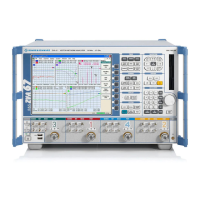System Overview
R&S
®
ZVA
45Getting Started 1145.1090.62 ─ 13
3 System Overview
The following chapter provides an overview of the analyzer's capabilities and their use.
This includes a description of the basic concepts that the analyzer uses to organize,
process and display measurement data, of the screen contents, possible measured
quantities, calibration methods and typical test setups.
For a systematic explanation of all menus, functions and parameters and background
information refer to the reference description on the graphical user interface (GUI Ref-
erence) in your analyzer's help system.
3.1 Basic Concepts
The analyzer provides a variety of functions to perform a particular measurement and
to customize and optimize the evaluation of results. To ensure that the instrument
resources are easily accessible and that user-defined configurations can be conven-
iently implemented, stored and reused the instrument uses a hierarchy of structures:
●
Global resources can be used for all measurements, irrespective of the current
measurement session or setup.
●
A setup comprises a set of diagram areas with all displayed information that can be
stored to a setup file.
●
The diagram areas show traces which are assigned to channels. See chap-
ter 3.1.3, "Traces, Channels and Diagram Areas", on page 46.
3.1.1 Global Resources
The analyzer provides global settings that are mostly hardware-related and can be
used for all measurements, irrespective of the current measurement session or setup.
Basic Concepts

